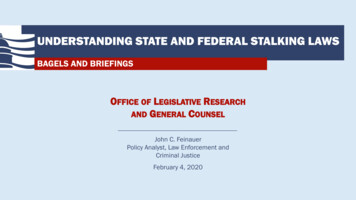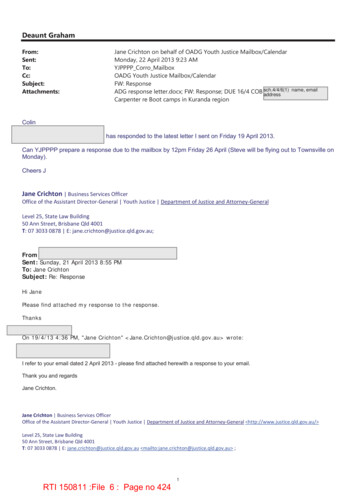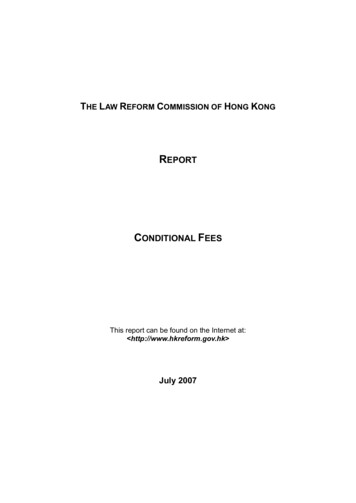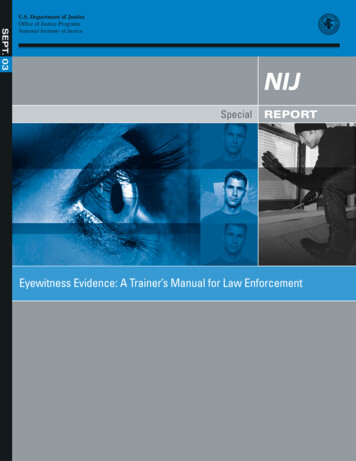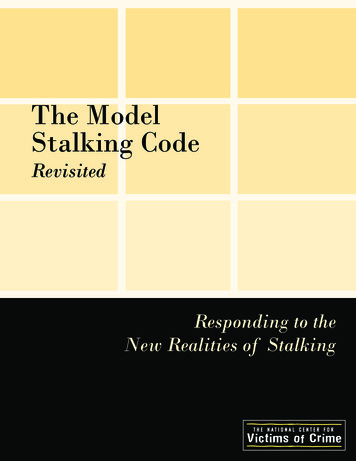
Transcription
The ModelStalking CodeRevisitedResponding to theNew Realities of Stalking
National Center for Victims of CrimeThe National Center for Victims of Crime is the nation’s leading resource andadvocacy organization dedicated to serving individuals, families, and communities harmed by crime. The mission of the National Center is to forge a nationalcommitment to help victims of crime rebuild their lives. Working with local,state, and federal partners, the National Center:Provides direct services and resources to victims of crime throughoutthe country;Advocates for laws and public policies that secure rights, resources,and protections for crime victims;Delivers training and technical assistance to victim service organizations, counselors, attorneys, criminal justice agencies, and alliedprofessionals serving victims of crime; andFosters cutting-edge thinking about the impact of crime and theways in which each of us can help victims rebuild their lives.A Leader in Responding to StalkingThe National Center for Victims of Crime has long led the field in enhancingour country’s response to stalking by advocating for key stalking legislationand policy at the federal and state level. In 2000, the National Center established the Stalking Resource Center to increase public awareness about stalkingand help communities across the country develop multidisciplinary responsesto this insidious crime. As the only national training and technical assistancecenter focused solely on stalking, the Stalking Resource Center has providedtraining to tens of thousands of victim service providers and criminal justicepractitioners throughout the United States and has fostered innovations in programs for stalking victims and practitioners who support them.For more information, please contact:National Center for Victims of Crime2000 M Street, NW, Suite 480Washington, DC 20036202-467-8700 www.ncvc.org 2007 National Center for Victims of Crime
The ModelStalking CodeRevisitedResponding to theNew Realities of StalkingJanuary 2007
AcknowledgementsAdvisory BoardThe National Center for Victims of Crime wishes to acknowledge theoutstanding efforts of the 23 members of the Model Stalking Code AdvisoryBoard who contributed an extraordinary wealth of knowledge and expertise tothis project.Howard BlackDetectiveColorado Springs Police DepartmentColorado Springs, COMary BolandChair, American Bar Association CriminalJustice Section Victim’s CommitteeAssistant State’s AttorneyCook County State’s Attorney’s OfficeChicago, ILHonorable Jerry BowlesJudgeJefferson CountyLouisville, KYAlana BowmanCity AttorneyCity of Los AngelesLos Angeles, CAScott GibsonPolice OfficerDomestic Violence UnitAlexandria Police DepartmentAlexandria, VAGretta GordyManaging AttorneyPennsylvania Coalition Against DomesticViolenceWashington, DCSally HillsmanExecutive OfficerAmerican Sociological AssociationWashington, DCKate KilleenDirector, Violence Against Women LegalEducation Prosecution ProjectCalifornia District Attorneys AssociationSacramento, CATom KirkmanAssistant District Attorney, DirectorDomestic Violence Prosecution UnitCape & Islands District Attorney’s OfficeBarnstable, MAHedda LitwinCybercrime and Violence Against WomenCounselNational Association of Attorneys GeneralWashington, DCVicky LutzExecutive Director, Women’s Justice CenterPace University School of LawWhite Plains, NYLaurie MarkonChildren’s Social WorkerAlexandria Domestic Violence ProgramAlexandria, VARhonda MartinsonStaff AttorneyBattered Women’s Justice ProjectMinneapolis, MN
Millicent Shaw PhippsSenior Attorney, National Center on FullFaith and CreditPennsylvania Coalition Against DomesticViolenceWashington, DCRobin RungeDirector, Domestic Violence SectionAmerican Bar Association Commission onDomestic ViolenceWashington, DCSudha ShettyDirector, Access to Justice InstituteSeattle University School of LawSeattle, WATom SmithDirector, Criminal Justice SectionAmerican Bar AssociationWashington, DCAllison TurkelSenior Attorney, National Center for theProsecution of Child AbuseAmerican Prosecutors Research InstituteAlexandria, VANancy TurnerSenior Program ManagerInternational Association of Chiefs of PoliceAlexandria, VAJennifer WoodsPolicy DirectorAlabama Coalition Against DomesticViolenceMontgomery, ALTim WoodsDirector of Research and DevelopmentNational Sheriffs AssociationAlexandria, VASeema ZeyaProgram Manager, Special ProgramDevelopmentDistrict of Columbia Metropolitan PoliceDepartmentWashington, DCJoan ZorzaEditor of the Domestic Violence Reportand the Sexual Assault ReportWashington, DCWe also acknowledge the outstanding efforts, expertise, and dedicationof the Model Stalking Code drafting committee members: Tracy Bahm, formerprogram director; Carol Dorris, senior attorney; Becky Hoey, former programattorney; Matthew Markon, former program attorney; Sandy Bromley, seniorprogram attorney; and consultant Deborah Goelman.In addition, many other professionals at the National Center for Victimsof Crime contributed their time and expertise to this project. Many thanks toMary Lou Leary, executive director for the National Center; Susan Howley,director of public policy; Ilse Knecht, deputy director of public policy; MichaelKaiser, director of program services; Michelle Garcia, program director; MaryRappaport, director of communications; Elizabeth Joyce, senior writer; KristiRocap, publications coordinator; Jen McLish, former program coordinator; andSusan Herman, former executive director of the National Center for Victims ofCrime.
TheModelStalkingCodeRevisitedTable of Contents99Introductory OverviewIntroduction10Historical Perspective12Rationale for Revisiting the 1993Model Anti-Stalking Code18Constitutional Challenges19Process of Updating the ModelStalking Code23Model Stalking Code for the States27Commentary to the Code27Legislative tion58Jurisdiction61Conclusion65AppendicesAppendix A: “Project to Developa Model Anti-Stalking Code forStates” (1993)Appendix B: Stalking Fact SheetAppendix C: OVC Bulletin“Strengthening Antistalking Statutes”
Section 1Introductory OverviewThe National Center for Victims of Crime has developed The ModelStalking Code Revisited: Responding to the New Realities of Stalking toassist states that are working to strengthen their stalking laws. This report examines and recommends updates to the 1993 Model Anti-Stalking Codefor the States developed at the direction of Congress by the National Instituteof Justice, U.S. Department of Justice.1IntroductionHow to Use This DocumentThe Model Stalking Code Revisited: Responding to the New Realities of Stalkingsuggests legislative language that may be used to better define and address thecurrent realities of stalking, hold stalkers accountable, and enhance the safetyof stalking victims.States may use this document as a guide to analyze current stalking statutes and to identify changes needed in their law.2 The statutory language recommended in this report and the accompanying commentary are designed to1 National Criminal Justice Association, Project to Develop a Model Anti-Stalking Code for States,(Washington, DC: National Institute of Justice, U.S. Department of Justice, 1993).2 The model legislation offered in this document is also applicable to territories and tribes. For easeof writing and reading, we have chosen to use only “states” throughout this document.Responding to the New Realities of Stalking 9
help legislators, criminal justice and victim assistance professionals, and otherswork toward amending current laws by expanding their awareness of the rangeof options available to them and of the impact that legislative language andstructure can have on the enforcement of the law.Document RoadmapThis document is presented in four sections. Section One provides an overviewthat includes a historical perspective of stalking legislation, a rationale forrevisiting the 1993 Model Anti-Stalking Code for the States, and a descriptionof the process used to update the code. Section Two provides model languagefor state stalking laws. Section Three provides a detailed commentary on eachsection of the model legislation, and Section Four provides a summation. TheAppendices provide additional resource materials, including the 1993 ModelAnti-Stalking Code for the States; a fact sheet produced by the Stalking ResourceCenter of the National Center for Victims of Crime that provides a comprehensive overview of all current relevant data on stalking; and the StrengtheningAntistalking Statutes Bulletin, published by the Office for Victims of Crime, U.S.Department of Justice.Historical PerspectiveThe criminalization of stalking occurred only after several high-profile cases,including the 1989 murder of actress Rebecca Schaeffer, gained national attention. Prior to its common usage and designation as a crime, stalking was referred to as harassment, obsession, or in some cases, domestic violence.Stalking is a crime of intimidation and psychological terror that oftenescalates into violence against its victims. Stalkers can destroy the lives of victims, terrorizing them through a course of conduct that may include monitoring, following, threatening, or harassing victims in a variety of ways. Stalkingoften has devastating consequences for victims. Many are forced to profoundlyalter their lives—going as far as relocating to another state and changing theiridentities—to protect themselves and their families.Victims’ experiences vary greatly—both the actual experience of beingstalked and the subsequent interactions with the criminal justice system and10 The Model Stalking Code Revisited
victim services field. The victim experience is largely dependent on the extentto which state laws hold offenders accountable and help keep victims safe.In 1990, California enacted the first state stalking law. Since then, all fiftystates, the District of Columbia, and the federal government have passed lawscriminalizing stalking. In 1996, Congress criminalized interstate stalking as afederal offense, later amending the statute to include stalking via electroniccommunications.3 An amendment adopted in 2006 expanded the federal stalking statute to include conduct which causes the victim substantial emotionaldistress.4 The new law also added language that would cover surveillance of avictim by a global positioning system (GPS).5Following the introduction of federal and state stalking laws—which varygreatly in scope and severity of penalties—law enforcement officers, prosecutors, and victim service providers began to steadily strengthen their response tostalking and their support for victims. But, as will be discussed later in this section, the laws have not kept pace with rapidly evolving stalking methods andhave, in fact, posed serious barriers to law enforcement officers and prosecutorsin making arrests and securing convictions.1993 Model Anti-Stalking CodeIn 1993, Congress directed the National Institute of Justice (NIJ) at the U.S.Department of Justice to develop a model anti-stalking code to encouragestates to adopt anti-stalking measures and to provide them with direction indrating such laws.6 NIJ entered into a cooperative agreement with the NationalCriminal Justice Association (NCJA) to research existing stalking laws and develop model legislative language. NCJA sought additional expertise and inputfrom the National Conference of State Legislatures, the American Bar Association, the National Governors’ Association, the Police Executive ResearchForum, the National Center for Victims of Crime, and other national organizations.318 U.S.C. § 2261A(2006).418 U.S.C. § 2261A(2)(B).518 U.S.C. § 2261A(2)(A).6 U.S. Departments of Commerce, Justice, and State, and the Judiciary and Related Agencies Appropriations Act for Fiscal Year 1993, Pub. L. No. 102-395, § 109(b).Responding to the New Realities of Stalking 11
When NCJA drafted the original anti-stalking code, many states had yetto enact stalking statutes, and stalking laws that had been enacted were newand untested in the courts. Because few courts had ruled on any constitutionalchallenges to stalking laws, the drafters created a model law designed to withstand the legal arguments that experts predicted at the time.The 1993 Model Anti-Stalking Code for the States served as an excellenttemplate for its time, an important early step toward ensuring that state criminal justice systems responded appropriately to stalking crimes. Many statesincorporated provisions of the original model code when drafting or expandingtheir state stalking statutes, and some courts referred to the model law wheninterpreting provisions in state stalking laws. (See Appendix A of this document for the 1993 model anti-stalking code.)Rationale for Revisiting the 1993 Model Anti-Stalking CodeSince the 1993 model anti-stalking code was developed, much more is knownabout the behavior of stalkers and the effectiveness of state stalking laws.7 Wehave witnessed an alarming rise in the use by stalkers of sophisticated—yetwidely available—tracking and monitoring technology. We also now possessquantifiable national data that documents the prevalence and severity of stalking.These developments strongly suggest the need for revisiting and updatingthe original model stalking code so that it reflects the current realities of stalking.Research on StalkingUntil recently, very little empirical data was available about stalking in theUnited States. A more accurate picture of stalking began to emerge with therelease of results from three major studies: the National Violence AgainstWomen Survey in 1998, the Intimate Partner Stalking and Femicide Studyin 1999, and the National Sexual Victimization of College Women Survey7 In 1993, the drafters titled the sample law the “Model Anti-Stalking Code for the States.” Due tothe current practice across the country of labeling such state laws “stalking laws” instead of “antistalking laws,” the updated sample law is called the “Model Stalking Code for the States.”12 The Model Stalking Code Revisited
in 2000.8 These studies provided new data on the prevalence of stalking, therelationship between victim and stalker, the lethality of stalking, and commonstalking behaviors.9According to the National Violence Against Women Survey, an estimated1.4 million people are stalked annually in the United States. This means thatone in 12 women and one in 45 men will be stalked at some point in their lives.10Seventy-eight percent of stalking victims are women, and 74 percent are between the ages of 18 and 39. Overall, 87 percent of stalkers are men: ninetyfour percent of women and 60 percent of men are stalked by men. Seventyseven percent of female stalking victims (and 64 percent of male victims) arestalked by someone they know, and 59 percent of female stalking victims (and30 percent of male victims) are stalked by an intimate partner or former intimate partner.11The Intimate Partner Stalking and Femicide Study, which studied femalemurder victims who had been killed by intimate partners, found that 76 percent of femicide victims and 85 percent of attempted femicide victims hadbeen stalked by their intimate partners in the year prior to their murders.12The National Sexual Victimization of College Women Survey showed aparticular vulnerability within a specific subgroup of victims, with thirteenpercent of college women reporting that they had been victimized by a stalkerin one six- to nine-month period.13 Consistent with the findings from other stud-8 Tjaden and Thoennes, “Stalking in America”; Judith McFarlane et al., “Stalking and IntimatePartner Femicide,” Homicide Studies 3, number 4 (November 1999); Bonnie Fisher, Francis T. Cullen,and Michael G. Turner, Sexual Victimization of College Women, (Washington, DC: National Institute ofJustice, U.S. Department of Justice, 2000).9 Beginning in 2006, stalking will be included in the annual National Crime Victimization Survey,conducted annually by the Bureau of Justice Statistics, U.S. Department of Justice, providing a reliable and regularly updated source of data on stalking prevalence rates.10 Tjaden and Thoennes, “Stalking in America,” 3.11 Ibid., 5-6.12 McFarlane et al., “Stalking and Intimate Partner Femicide,” 308. Femicide is the murder of afemale.13Fisher, Cullen, and Turner, Sexual Victimization of College Women Survey, 27.Responding to the New Realities of Stalking 13
ies, more than 80 percent of these women knew their stalker, who was often acurrent or former boyfriend.14These landmark studies shed new light on specific stalking behaviors. Themost commonly reported stalking behaviors were surveillance behaviors, suchas following or spying on the victim, or waiting outside the victim’s home,work, or school. Unwanted phone calls, letters, and gifts were also commonlyreported by victims. Fewer than 50 percent of victims reported being directlythreatened by their stalkers. (For additional stalking data, see the stalking factsheet in Appendix B of this document.)Significance of These Studies. The findings from this research providecrucial cues to drafters of stalking legislation. The research shows, for example,that stalking is often linked closely with intimate partner violence. Law enforcement experts and victim advocates understand intimate partner violenceas a pattern of controlling behavior that one intimate partner directs at another. When a victim leaves an abusive relationship, the risk of violence actuallyincreases because the victim has challenged the perpetrator’s unilateral exerciseof power and control. The perpetrator often lashes out violently toward thevictim in an attempt to retain or regain power and control. This “separationviolence” often includes both stalking and physical violence.15 Stalking lawsneed to be drafted in such a way that law enforcement can intervene as early aspossible in intimate partner situations, before behaviors escalate into more serious violence.The research also shows that surveillance is the most common type ofstalking behavior victims experience. Stalkers can now terrorize their victims inalmost any environment. Additionally, stalkers inflict terror and severe emotional distress without ever communicating direct or overt threats. Stalkers14Ibid., 28.15 “Stalking in America: The National Violence Against Women Survey,” by Tjaden and Thoennes,documented the danger of separation violence by asking women who had been stalked by their formerhusbands or partners at what point in the course of the relationship the stalking had occurred. Twenty-one percent of the victims said the stalking occurred only before the relationship ended; 43 percentsaid it occurred only after the relationship ended; and 36 percent said it occurred both before andafter the relationship ended. Callie Marie Rennison and Sarah Welchans, in “Special Report: IntimatePartner Violence,” with results drawn from the National Crime Victimization Survey, also found thatdivorced or separated persons were subjected to the highest rates of intimate partner victimization.14 The Model Stalking Code Revisited
torment their victims, who often cannot perform everyday tasks such as answering their phones, reading their mail, or using their computers without fearof unwanted contact from the person who is stalking them.The variability of stalking behaviors suggests that laws must be broadenough to address stalking in all its forms.Stalking through New TechnologyStalkers increasingly use technology to surveil, monitor, track, and terrorize victims. When the original model anti-stalking code and most of the statestalking statutes were drafted in the early 1990s, many of today’s technologiesdid not exist or were not affordable or readily available to the public. New, affordable technology has fundamentally and profoundly changed the way stalkers monitor and initiate contact with their victims. A stalker no longer needs tobe in close proximity to his victim to monitor or surveil her. He can use a globalpositioning system (GPS) to track her in her car as she travels to virtually anylocation. He can put a small hidden camera (often called a “spycam”) in hisvictim’s home and have access to even the most private moments of her life. Hecan put a spyware program on her computer and intercept all of her e-mailsand Internet searches.All of these forms of technological stalking can be done from a distance—something that was not anticipated when the early stalking laws were draftedto prohibit physically following and pursuing another person. In the early1990s, many stalking laws required physical proximity to satisfy the definitionof stalking—a requirement made irrelevant by the new widely available monitoring technology.Stalkers’ use of e-mail to contact victims has prompted many jurisdictionsto pass so-called “cyberstalking” laws. While these laws provide another meansof holding stalkers accountable, enacting multiple statutes that criminalizedifferent types of stalking behavior has significant drawbacks. Stalkers oftenuse a variety of methods to terrorize victims, and the course of conduct required under many stalking laws is established by looking at the totality of thestalker’s conduct. Passing separate laws for stalking and cyberstalking oftencreates unintended consequences such that prosecutors have trouble choosingthe statute under which to prosecute a case. The bifurcation of stalking laws,Responding to the New Realities of Stalking 15
for example, can make it difficult to collect sufficient evidence to convict underone or the other statute.In addition, cyberstalking laws typically only address stalking committed through the Internet (cyberspace). Instead of a state passing a new law tocover each new method of stalking, the focus should be on drafting a single lawthat covers stalking by any method, whether in person or by vehicle, telephone,pager, GPS, e-mail, spycam, or other means. The challenge is to enact laws thataddress stalking perpetrated through all of the currently known technologies,as well as through future technologies not yet developed or available to stalkers.The National Center ExperienceFor nearly two decades, the National Center for Victims of Crime has led thefield in enhancing our country’s response to stalking. Since the enactment ofthe country’s first state stalking law in 1990, the National Center has supportedscores of legislators and victim advocates across the country in their efforts topass state stalking laws or strengthen existing laws.The National Center has also played a pivotal role in shaping federal stalking law by providing technical assistance to lawmakers, commenting on proposed legislation, and testifying before Congress. The National Center was critical in ensuring that legal protections keep pace with technology by advocatingthat the federal stalking statute include stalking behaviors that occur via theInternet or by other electronic means, such as tracking by GPS.In 2000, the National Center established the Stalking Resource Center, theonly national training and technical assistance center focused solely on stalking. The Stalking Resource Center has provided training to tens of thousandsof victim service providers and criminal justice practitioners throughout theUnited States and has fostered innovations in programs for stalking victims andpractitioners who support them.The National Center operates the National Crime Victim Helpline,1-800-FYI-CALL, through which victims receive one-on-one support to helpthem understand the impact of crime, access victim compensation, developsafety plans, navigate the criminal justice and social service systems, learnabout their legal rights and options, and find the most appropriate local services. Nearly one-fifth of the calls received by the National Center come from16 The Model Stalking Code Revisited
stalking victims, many of whom relay disturbing experiences with a criminaljustice system that poses significant hurdles to making stalkers accountable forthis crime.The National Center’s extensive stalking policy and training experienceand its regular interaction with law enforcement professionals, victim serviceproviders, and victims of crime have provided a unique insight into the inadequacies of the nation’s current body of stalking laws. We’ve learned that: Stalkers often can “get away” with their criminal behavior and continue to wreak havoc on a victim’s life with little or no risk of intervention by law enforcement. The burden of proof is so high under many stalking laws that it is extremely difficult to secure convictions. In most jurisdictions, stalking is only a misdemeanor crime, and sentences longer than a few days or weeks are rare. Most stalkers spend aremarkably short time in custody if and when they are arrested, prosecuted, and convicted. Statutory provisions written with the “stranger” stalker in mind restrict the types of stalking behavior that can be prosecuted when thestalker and victim are in a relationship. Without a full appreciation of the role of context in a stalking situation—the private meaning of certain behaviors that would not necessarily be evident to an outside observer—many stalking behaviorscan be viewed as harmless, when in fact the behaviors may terrify thevictim. A love letter left on the doorstep of a victim’s apartment, forexample, might seem benign to a law enforcement officer. Withoutknowing the context, the officer cannot fully appreciate how terrifying that apparently harmless gesture is for a victim who believed herstalker did not know where she was. Current state laws do not address the full range of stalking behaviors,making it virtually impossible to arrest and prosecute an offender formany of those behaviors. Consider, for example, a situation in which astalker is constantly watching and monitoring a victim’s daily activities and has posted information about the victim on the Internet, buthas never communicated directly with the victim or threatened theResponding to the New Realities of Stalking 17
victim in any way. If, as is often the case, the applicable statute requires proof of some type of communication or threatening contact bythe stalker, it is unlikely that a stalking charge could be brought. Manystate stalking laws simply do not address surveillance by stalkers withnewer forms of technology that do not require proximity to or communication with the victim.Constitutional ChallengesBroadening the definition of stalking to allow the criminal justice system tointervene before stalking escalates into violence is the ultimate goal. Changes inexisting stalking laws, however, should always be made with careful consideration of constitutional limits established by the courts.Since 1993, courts across the nation have heard appeals from defendantschallenging their convictions on constitutional grounds, with stalking lawsstanding up to constitutional challenges time after time.Many cases challenging the constitutionality of stalking laws have focusedon one of two questions: (1) whether the statute is overbroad and therefore violates the First Amendment, or (2) whether the statute is vague and violates theFifth and Fourteenth Amendments of the United States Constitution.16Courts have determined that most stalking laws are not overbroad orvague and do not deny defendants their due process rights. Those cases inwhich courts have struck down stalking law provisions have helped legislatorsunderstand the constitutional parameters of stalking laws.17 (For more detailed16 Office for Victims of Crime, Office of Justice Programs, U.S. Department of Justice, “Strengthening Antistalking Statutes,” Legal Series Bulletin 1 (January 2002): 3.The First Amendment “doctrine of substantial overbreadth” allows a person to challenge a stalking statute on the grounds that it may be unconstitutionally applied to legal behaviors. The Fifth andFourteenth amendments guarantee citizens due process rights, including effective notice of the behavior that is criminalized by stalking statutes. 16 AM. JUR. 2D Constitutional Law § 140 (2006).A person may also challenge a stalking statute on the ground that the notice given (via the statute)is so vague that it leaves a person without knowledge of the nature of activity that is prohibited. 16BAM. JUR. 2D Constitutional Law § 920 (2006).17 For example, in Commonwealth v. Kwiatkowski, 418 Mass. 543, 637 N.E.2d 854 (Mass. 1994), thecourt found the stalking statute unconstitutionally vague and overturned the defendant’s conviction,but then interpreted the statute and defined exactly what type of behavior would be covered by thestatute.18 The Model Stalking Code Revisited
discussion on constitutional challenges to stalking laws, see “OVC Bulletin:Strengthening Antistalking Statutes,” Appendix C.)Process of Updating the Model Stalking CodeLegal ResearchThe National Center for Victims of Crime began this project by reviewing eachstate’s stalking law and analyzing several elements in the laws, including: Prohibited acts Level of intent (general or specific) Type of fear required (reasonable person, actual fear, or both) Degree of fear (e.g., serious bodily injury or emotional distress) Target of stalker’s acts (victim, victim’s family, other third parties) Threat requirements Coverage of technology and surveillance Other miscellaneous or innovative provisionsThese elements make up the core of almost all stalking laws, but thelanguage and standards adopted by the states vary greatly. In fact, what constitutes a crime in one state may be completely legal in another. The variancesin these elements determine what prosecutors must prove to hold stalkers accountable, as well what stalking victims must experience before the criminaljustice system can intervene.The Model Stalking Code drafting committee compared each state’s treatment of the above elements. The specific find
In 1993, Congress directed the National Institute of Justice (NIJ) at the U.S. Department of Justice to develop a model anti-stalking code to encourage states to adopt anti-stalking measures and to provide them with direction in drating such laws.6 NIJ entered into a cooperative agreement with the National Criminal Justice Association (NCJA) to .


